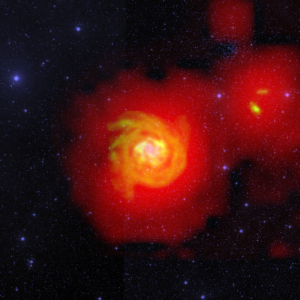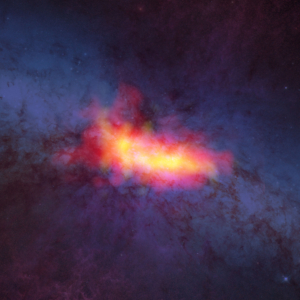Composite image of supernova 1987A. ALMA data (red) shows newly formed dust in the center of the remnant. HST (green) and Chandra (blue) show the expanding shockwave.


Dust Bowl of Supernova 1987A
This artist’s illustration of supernova 1987A reveals the cold, inner regions of the exploded star’s remnants (red) where tremendous amounts of dust were detected and imaged by ALMA. This inner region is contrasted with the outer shell (blue), where the energy from the supernova is colliding (green) with the envelope of gas ejected from the star prior to its powerful detonation.

Powerful Jets of Young Stars
Inside a gigantic cloud of dark molecules and gas is a pair of young stars known as HH46/47. One of these stars is going through a normal but violent phase where its magnetic poles act like railways to channel charged particles away from the star. ALMA observed tons of molecules traveling out of this star along these jets at superfast speeds. These outflows eventually distort and help clear away the cloud from around the star. In this false-color image from ALMA, blue shows jet material heading toward us and red marks the jet particles speeding in the opposite direction.

Crab Nebula
The Crab Nebula, located in the constellation of Taurus, is the remnant of a star that exploded in 1054 AD. The nebula is roughly 10 light-years across, and it is at a distance of about 6,000 light years from earth. It is presently expanding at about 1000 km per second. The supernova explosion left behind a rapidly spinning neutron star, or a pulsar (not discernible in this image). The present remnant is formed from both the material originally thrown off by the star in the supernova explosion, and from a highly energetic wind from the pulsar. It is this wind which energizes the nebula, and causes it to emit the radio waves (purple, blue, green). Gases glow so brightly that they can be seen optically as well (red).

Rivers of Hydrogen Connect Clusters of Galaxies
This composite image contains three distinct features: the bright star-filled central region of galaxy NGC 6946 in optical light (blue), the dense hydrogen tracing out the galaxy’s sweeping spiral arms and galactic halo (orange), and the extremely diffuse and extended field of hydrogen engulfing NGC 6946 and its companions (red). The new GBT data show the faintly glowing hydrogen bridging the gulf between the larger galaxy and its smaller companions. This faint structure is precisely what astronomers expect to appear as hydrogen flows from the intergalactic medium into galaxies or from a past encounter between galaxies.

M82 As Seen By the GBT
This composite image of starburst galaxy M82 shows the distribution of dense molecular gas as seen by the GBT (yellow and red) and the background stars and dust as seen by Hubble (blue). The yellow areas correspond to regions of intense star formation. The red areas trace outflows of gas from the disk of the galaxy.





